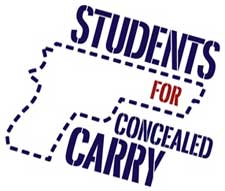

AUSTIN, TX – The anti-campus carry professors behind Gun Free UT love to cite statistics suggesting that a concealed handgun license (CHL) holder is more likely to commit a mass shooting than to stop one; however;
Gun Free UT’s statistics—which are never offered with any type of context—are at best misleading and at worst untrue.
Gun Free UT likes to claim that concealed handgun license holders have committed twenty-nine mass shootings since 2007; however, an examination of those twenty-nine incidents reveals twenty-six in which licensed concealed carry played no part whatsoever, two in which it is highly unlikely that licensed concealed carry played any part, and one in which licensed concealed carry very well may have played a part. The one incident in which licensed concealed carry may have played a part resulted in only three murders (the minimum to qualify as a “mass killing”), took place during a confrontation at the home of the perpetrator’s ex-wife.
The perpetrator should never have been ineligible to own a gun, much less obtain a concealed handgun license, but still received a Pennsylvania license due to an error in the criminal database.
Gun Free UT points out that one CHL holder was paralyzed while attempting to intervene in a mass shooting; however, the group fails to include the context that this incident took place in a state with no training requirement for license applicants [not that it should be needed] and that the license holder broke one of the first rules of licensed concealed carry—he inserted himself into a crime that did not already involve him.
When he reached the gunman, he chose to issue a warning rather than open fire, which gave the gunman time to turn and shoot.
Gun Free UT notes that another CHL holder was killed while attempting to confront an active shooter; however, the group fails to include the context that this license holder was killed by the until-then unseen partner of the confronted gunman.
This license holder was unfortunate enough to encounter one of the 1.25% of active-shooter incidents involving more than one gunman.
Gun Free UT claims that a CHL holder almost shot the wrong person during the attack on Congresswoman Gabrielle Giffords; however, this is untrue. The armed citizen who attempted to intervene during the shooting was not a license holder—he was carrying a handgun under the authority of Arizona’s then-six-month-old “constitutional carry” (aka unlicensed carry) law. By his own admission, he had no formal training, which means he could not have been licensed under the previous law.
Furthermore, it’s worth pointing out that, although he did make the mistake of inserting himself into a crime that did not already involve him, he at least had the good sense not to draw his weapon.
Gun Free UT argues, “The FBI found only 1 of 160 active shooter incidents between 2000-2014 was stopped by a CHL holder, and he was a Marine; 21 incidents were stopped by UNARMED civilians”; however, this assumes that armed license holders were present at most of those incidents. A quick look at Texas Department of Public Safety statistics shows that the average rate of concealed handgun licensure among Texans from 2000 to 2013 (the FBI study referenced by Gun Free UT actually extended through 2013, not 2014) was 1.45%. That means that only one person out of every 69 was licensed to carry a concealed handgun, and we can assume that far fewer actually carried guns on a daily basis.
Furthermore, many of the active shooter incidents listed occurred in locations where licensed concealed carry was prohibited. Of the 21 incidents stopped by unarmed civilians, 11 occurred in schools.
According to one gun-rights research group, there have been “only two mass public shootings since at least 1950 that have not been part of some other crime where at least four people have been killed in an area where civilians are generally allowed to have guns.” This source obviously isn’t unbiased, and they admit to having looked only at “public shootings…where the point of the attack is simply to kill as many people as possible,” but this finding combined with the relatively low rate of licensure during the 2000-2013 period does give us reason to believe that maybe—just maybe—it’s unreasonable to assume that CHL holders would have been directly involved (not just somewhere nearby) in a large number of active-shooter incidents.
Isn’t it at least somewhat telling that Gun Free UT can only report two incidents of license holders being injured or killed during active-shooter incidents?
To suggest that more mass shootings/active-shooter incidents should have been stopped by CHL holders is to suggest that license holders should have been acting as de facto security guards for everyone around them. However, as already mentioned, license holders are taught to move away from danger and to avoid inserting themselves into any crime that doesn’t already involve them. Licensed concealed carry is about personal protection, not public protection. At the first sound of gunshots, a well-trained, self-aware CHL holder is going to look for cover and then look for an exit before even thinking about trying to engage an unknown assailant.
Gregg Easterbrook famously said, “Torture numbers, and they’ll confess to anything.” It’s true that both sides of this debate have a sizable pool of statistics to pull from. But the statistics cited by Gun Free UT are largely red herrings and rebuttals to straw man arguments.
They claim, “In Colorado and Utah, states with classroom carry, for example, the presence of guns in dorms has led to increases in campus rape reports,” despite the fact that the study cited as a source for that claim clearly states that its results “certainly do not prove that concealed carry causes more crime” and despite the fact that neither Colorado nor Utah has seen a single report of an on-campus sexual assault committed by a license holder with a handgun.
They claim, “The NRA has blocked the study of crime rates by CHL holders and other gun-violence related claims,” even though the source they cite refers only to federal funding for the CDC (there is no mention of CHL holders) and doesn’t address the fact that Texas still maintains data on convictions of CHL holders and that universities still manage to get funding for gun-violence research.
They claim, “Concealed carry permits do not decrease crime,” but a decrease in crime was never one of the talking points behind Texas Senate Bill 11 (campus carry). Remember, campus carry is about personal protection, not campus protection. We’re not trying to supplement campus police; we’re just trying to ensure that trained, licensed, carefully screened adults (age 21 and above) enjoy the same rights on campus as virtually everywhere else.
Students for Concealed Carry isn’t perfect. We’ve found ourselves mistakenly using misleading or downright false statistics in the past.
But when we did, we stopped using those statistics. We didn’t build an entire campaign around them.
ABOUT STUDENTS FOR CONCEALED CARRY — Students for Concealed Carry (SCC) is a national, non-partisan, grassroots organization comprising college students, faculty, staff, and concerned citizens who believe that holders of state-issued concealed handgun licenses should be allowed the same measure of personal protection on college campuses that current laws afford them virtually everywhere else. SCC is not affiliated with the NRA or any other organization. For more information on SCC, visit ConcealedCampus.org or Facebook.com/ConcealedCampus. For more information on the debate over campus carry in Texas, visit WhyCampusCarry.com.

Never utilize proven facts when discussing firearms-related information with liberals, it simply doesn’t fit their hysterically-biased agenda. They’re so desperately afraid of firearms, they actually cannot accept the well proven fact that firearms generally make people safer.
Plus, it’s so much easier for them to remain helpless victims because they truthfully believe that it’s the government’s responsibility to care for them. Because they can’t or won’t take the personal responsibility to defend themselves.
Ever notice mass shootings are generally in restricted carry states. Maybe because it’s that in Constitutional carry states they know , someone may have firearm and cap them before they do their evil deed.
That A&M so-called “study” was flawed from the outset, and its methodology was laughably inept. Its conclusions were way off-base. Even if it had indeed been scientifically sound and verifiable (which it absolutely was not!)… it only showed that campus-carry did not affect overall crime. It very pointedly omitted the positive effect it had on specific individual crimes. And no empirical evidence, anywhere – even in the most liberally-skewed, twisted- statistics propaganda – has ever shown concealed-carry (on or off campuses) to have any detrimental effect of increasing crime. So there is no justification for any governmental entity denying its… Read more »
Students for Concealed Carry (SCC) is a nation-wide movement initiated and supported by the Gun Owners of America (GOA), an ultra-conservative, extremist group led by Larry Pratt, who has ties to the KKK and fanatical Christian Evangelism. A recent Texas A&M study concluded that CHL holders do not reduce crime in 4 states (including Texas). Likewise, in Colorado and Utah, campus carry has not reduced the rate of violent crime. Thus, there is little justification for having firearms on campus. The 2008 D.C. vs Heller decision also supports keeping firearms off campus: “Like most rights, the second amendment is not… Read more »
You have to love it when academicians issue sophistries in order to validate their position, when then makes you wonder what kind of education the students are actually getting. Woe is society when an educator is listened to outside of the classroom.